![]()
![]()
![]()
Use LEFT and RIGHT arrow keys to navigate between flashcards;
Use UP and DOWN arrow keys to flip the card;
H to show hint;
A reads text to speech;
23 Cards in this Set
- Front
- Back
|
Inhumation vs. Cremation
|
-Cremation standard in later Republican and Julio-Claudia times
-Inhumation-->carved stone sarcophagi accepted in Trajan Era -No obvious changes in religious practices (inhumation may be a result of a larger influence of Christianity and the idea of an afterlife for the body) |
|
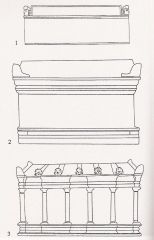
Sarophagi: Basic Info
examples 1. Rome, 2. Athens, 3. Asia Minor |
-Displayed inside and outside mausolea
-Western: intended for tomb interiors; only 3 sided; rectangular; flat or slightly sloping lids framed by heads or masks -New Shape: round ended or 'lenos'; evolved in later western times -Eastern: carved on 4 sides; meant to be encircled; gabled roofs--> resembled temples & tombs of the dead -Production veritable industry in Mediterranean in 2nd & 3rd c.; workshops in Rome, Athens, and Asia Minor |
|
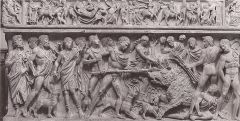
Mythological Sarcophagi: Orestes Sarcophagus, Porta Viminalis, 132-134 (Hadrian Age 76-138 AD)
|
Date: 134-140 ca.
Material: Marble Size: 2' 11" x 7' 5/8" Location: Outside Porta Viminalis Style: -standard western type (sloping lid, reliefs on front and sides) -Myth of Orestes: Popular in Antonine era. -Orestes appears 3 times: visiting grave of father agamemnon, defending mother Clytaemnestra & her lover, & defending himself against Erinyes |
|

Mythological Sarcophagus: Orestes Sarcophagus, 135 ca. (Hadrian Age 76-138 AD)
|
Date: 140-150 ca.
Material: Marble Size: 2' 7 1/2" Style: -standard western type (sloping lid, reliefs on front and sides) -Myth of Orestes: Popular in Antonine era. -Orestes appears twice: defending mother Clytaemnestra & her lover, & defending himself against Erinyes |
|
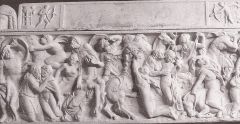
Mythological Sarcophagi: Niobids Sarcophagus, ca. 134-140 (Hadrian Age 76-138 AD)
|
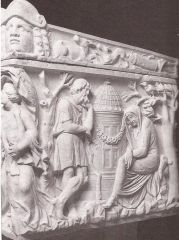
Date: 134-140 ca.
Location: Found outside Porta Viminalis Size: 3' 5/8" x 6' 11" Material: Marble Style: -1 of earliest 2nd c. sarcophagi; standard western type (sloping lid, reliefs on front and sides); Depicts myth: retribution against Niobe for boasting she was better than Leto b/c she had more children; (right) Niobe tries to protect children, (left) husband raises shield; (short end above) mourning deaths |
|

Mythological Sarcophagi: Sarrcophagus with battle between the Greek and the Amazons, 140-150, Museo Capitolino (Antonine Age: 138-193)
|
Location: From Via Collatina, Rome
Date: 150 ca. Size: 2' 1 5/8" x 8' 2" Material: Marble Style: -Battle Sarcophagus (displays manly virtue of valor & unending military campaigns of 2nd c.) -Mythological (no battle ever occurred); ragging battle on sides, dejected amazons on lid -Amazons= prominent in Greek art; allegories for historical events --> connection between amazonian battle & Antonine warfare (evident in 2 figures of victory [front left & right]) |
|
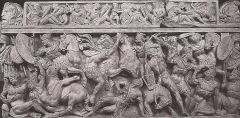
Mythological Sarcophagi: Sarcophagus with the battle between Greek and Gauls, 170 ca., Museo Capitolino (Antonine Age: 138-193)
|
Location: From Via Appia, Rome
Date: 160-170 ca. Material: Marble Size: 4' 1 1/4" x 6' 11" Style: -Battle Sarcophagus (displays manly virtue of valor & unending military campaigns of 2nd c.) -Legendary historical battle -Lid: seated captured Gauls (depicted similarly to Amazons); below heavily armed Greeks; inevitable victory; -Similar motifs to the reliefs of the Tiberian arch |
|
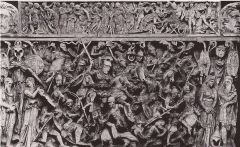
Battle Sarcophagi: Antonine Age: Portonaccio Sarcophagus, 180-190 (Antonine Age: 138-193)
|
-All surviving Battle Sarcophagus date to last 3 decades of 2nd c. (Military preoccupations of Marcus Aurelius)
-Most housed remains of Military commanders and soldiers -scenes spread main body of sarcophagus sometimes onto lid; close in subject matter, format, and style, to scenes in state relief sculpture Location: From Via Tiburtina, Portonaccio Date: 180-190 ca. Material: Marble Size: 3' 8 7/8" x 7' 10 1/8" Style: -Battle Sarcophagus -Made in workshops for purchase to anyone (no distinguishable portraits of deceased) -Central figure: faceless general battling barbarians (similar motif to Trajan battling Dacians; however composition similar to column of Marcus Aurelius [tiers of figures spread over full height]) |
|

Biographical Sarcophagi: Clementia Sarcophagus, ca.170 (Antonine Age: 138-193)
|
-Allusion to battle, but no scenes of battle
-Scenes from both public and private life: Roman general scenes of clementia -Major events are highlighted in shorthand vignettes -Scenes meant to encapsulate the deceased's virtus, clementia, pietas, and concordia |
|

Biographical Sarcophagus: Marriage Sarcophagus, ca 170, Mantua (Antonine Age: 138-193)
|
-Allusion to battle, but no scenes of battle
-Scenes from both public and private life: Roman general portrayed in scenes of clementia, sacrifice, and marriage (combination of scenes) -Major events are highlighted in shorthand vignettes -Scenes meant to encapsulate the deceased's virtus, clementia, pietas, and concordia |
|

Biographical Sarcophagus: Sarcophagus of a shoemaker, Ostia, Trajanic
|
-Scenes from both public and private life: life of a shoemaker
-Major events are highlighted in shorthand vignettes -Inscription plaque with an epitaph, that states that the sarcophagus was dedicated by Lucius Atilius Artemas and Claudia Apphias in honor of their friend, Titus Flavius Trophimas |
|

Mythological Sarcophagus: Melfi Sarcophagus, 165-170 (Antonine Age: 138-193)
|
Title: Sarcophagus with kline portrait of a woman
Location: From Rapolla, near Melfi Date: 165-170 ca. Material: Marble Size: 5' 7" Style: -Asiatic type of Sarcophagus (statuesque figures on all 4 sides Depicted: major Greek gods |
|
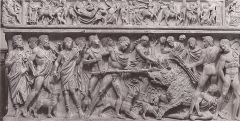
Mythological Sarcophagus: Meleager Sarcophagus, ca. 180 (Antonine Age: 138-193)
|
Location: From Rome
Date: 180 ca. Material: Marble Size: 3' 1" x 8' 1 1/4" Style: -Greek figure Meleager (model of valor) -western sarcophagus -Popular as a result of Hadrian (made hunting popular) |
|
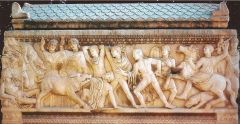
Mythological Sarcophagus: Meleager Sarcophagus, ca. 200
|
Location: From Eleusis, Greece
Date: 200 ca. Material: Marble Style: -Greek figure Meleager (model of valor) -eastern sarcophagus (standard gable roofed lid of eastern sarcophagi) -Popular as a result of Hadrian (made hunting popular) |
|
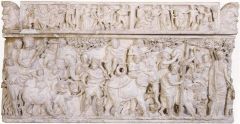
Dionysiac Sarcophagi: CA. 180 (Antonine Age: 138-193)
|
-In a group of 10 found in 1855 in 2 chambers of a large tomb belonging to the Calpurnii Pisones in a cemetery of the Via Salaria
- |
|

Egyptian Mummies: Mummy of Artemidorous 100-120
|
-Found in Site called Valley of the Golden Mummies
Location: Hawara, Egypt Date: 100-120 ca. Material: Mummy case: stucco with gold leaf; Portrait: Encaustic on wood Preservation: fully preserved Size: apx. 5' 7 1/4" Style: -Portraits likely painted when alive and cut down to fit cases -case: Egyptian funerary motifs; largest scene bellow head: god of mummification preparing body on looked by 2 goddesses; Osiris depicted rising from bier (obvious theme of resurrection) -Portrait: youthful (died young); wreath, hair combed (popular style in Trajan principate) |
|
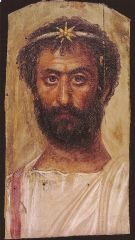
Mummy Portrait of a priest of Serapis, ca. 140-160
|
-Found in Site called Valley of the Golden Mummies
Location: From Hawara, Egypt Date: 140-160 ca. (due to length of hair & beard) Material: Encaustic on wood Size: 1' 4 3/4" x 8' 3/4" Style: -distinctive hairstyle: 3 curly locks on forehead: adherent of cult of Serapis -drapery basically rendered |
|
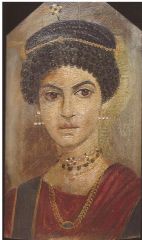
Mummy Portrait of a young woman, ca. 110-120
|
-Found in Site called Valley of the Golden Mummies
Location: From Hawara, Egypt Date: 110-120 ca. (based on hairstyle; early Sabina) Material: Encaustic on wood Size: 1' 5 1/4" x 1' 1 3/8" Style: -dubbed jewelery girl due to adornment -drapery basically rendered |
|
|
Social Considerations
|
-Few roman sarcophagi have been found, few have surviving epitaphs-->therefore difficult to establish patrons social position
-high cost suggests well off patrons -aristocratic form of art -commissioned by freedmen (taste for ostentatious funerary monuments) |
|
|
Western Sarcophagi
|
-back was not carved
|
|
|
eastern sarcophagi
|
-rendered on all sides
-Continuous friezes |
|
|
Asia Minor Sarcophagi
|
-rendered on all sides (eastern sarcophagi)
-statuesque figures between columns/ sides |
|
|
Egyptian Mummies
|
-Buried in Mummy cases
-Encaustic portraits on wooden panels -Evidence of evolution of portrait painting in antiquity |

